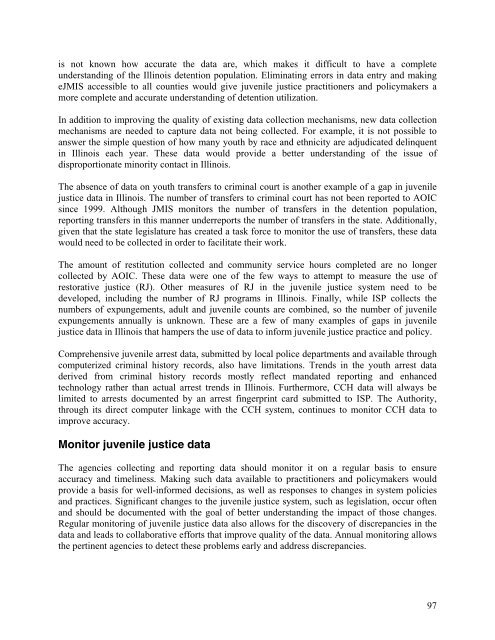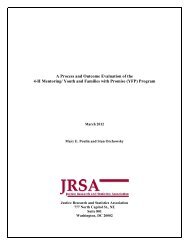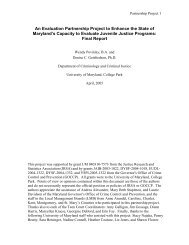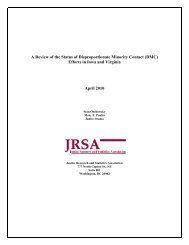Juvenile Justice System and Risk Factor Data - Illinois Criminal ...
Juvenile Justice System and Risk Factor Data - Illinois Criminal ...
Juvenile Justice System and Risk Factor Data - Illinois Criminal ...
You also want an ePaper? Increase the reach of your titles
YUMPU automatically turns print PDFs into web optimized ePapers that Google loves.
is not known how accurate the data are, which makes it difficult to have a complete<br />
underst<strong>and</strong>ing of the <strong>Illinois</strong> detention population. Eliminating errors in data entry <strong>and</strong> making<br />
eJMIS accessible to all counties would give juvenile justice practitioners <strong>and</strong> policymakers a<br />
more complete <strong>and</strong> accurate underst<strong>and</strong>ing of detention utilization.<br />
In addition to improving the quality of existing data collection mechanisms, new data collection<br />
mechanisms are needed to capture data not being collected. For example, it is not possible to<br />
answer the simple question of how many youth by race <strong>and</strong> ethnicity are adjudicated delinquent<br />
in <strong>Illinois</strong> each year. These data would provide a better underst<strong>and</strong>ing of the issue of<br />
disproportionate minority contact in <strong>Illinois</strong>.<br />
The absence of data on youth transfers to criminal court is another example of a gap in juvenile<br />
justice data in <strong>Illinois</strong>. The number of transfers to criminal court has not been reported to AOIC<br />
since 1999. Although JMIS monitors the number of transfers in the detention population,<br />
reporting transfers in this manner underreports the number of transfers in the state. Additionally,<br />
given that the state legislature has created a task force to monitor the use of transfers, these data<br />
would need to be collected in order to facilitate their work.<br />
The amount of restitution collected <strong>and</strong> community service hours completed are no longer<br />
collected by AOIC. These data were one of the few ways to attempt to measure the use of<br />
restorative justice (RJ). Other measures of RJ in the juvenile justice system need to be<br />
developed, including the number of RJ programs in <strong>Illinois</strong>. Finally, while ISP collects the<br />
numbers of expungements, adult <strong>and</strong> juvenile counts are combined, so the number of juvenile<br />
expungements annually is unknown. These are a few of many examples of gaps in juvenile<br />
justice data in <strong>Illinois</strong> that hampers the use of data to inform juvenile justice practice <strong>and</strong> policy.<br />
Comprehensive juvenile arrest data, submitted by local police departments <strong>and</strong> available through<br />
computerized criminal history records, also have limitations. Trends in the youth arrest data<br />
derived from criminal history records mostly reflect m<strong>and</strong>ated reporting <strong>and</strong> enhanced<br />
technology rather than actual arrest trends in <strong>Illinois</strong>. Furthermore, CCH data will always be<br />
limited to arrests documented by an arrest fingerprint card submitted to ISP. The Authority,<br />
through its direct computer linkage with the CCH system, continues to monitor CCH data to<br />
improve accuracy.<br />
Monitor juvenile justice data<br />
The agencies collecting <strong>and</strong> reporting data should monitor it on a regular basis to ensure<br />
accuracy <strong>and</strong> timeliness. Making such data available to practitioners <strong>and</strong> policymakers would<br />
provide a basis for well-informed decisions, as well as responses to changes in system policies<br />
<strong>and</strong> practices. Significant changes to the juvenile justice system, such as legislation, occur often<br />
<strong>and</strong> should be documented with the goal of better underst<strong>and</strong>ing the impact of those changes.<br />
Regular monitoring of juvenile justice data also allows for the discovery of discrepancies in the<br />
data <strong>and</strong> leads to collaborative efforts that improve quality of the data. Annual monitoring allows<br />
the pertinent agencies to detect these problems early <strong>and</strong> address discrepancies.<br />
97

















